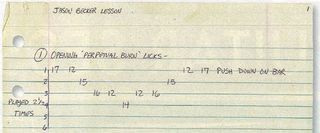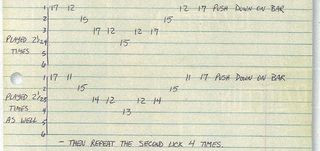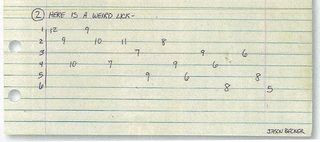Are you a guitar enthusiast eager to master “Perpetual Burn” on guitar? At guitarplayers.net, we provide comprehensive lessons for guitarists of all skill levels, helping you navigate the intricate licks and techniques required to play this iconic piece, offering guitar instruction, guitar tabs, and guitar tutorials. Learn how to play guitar with passion and precision.
1. What Makes “Perpetual Burn” a Must-Learn for Guitarists?
“Perpetual Burn,” composed by the legendary Jason Becker, stands out as a pivotal instrumental piece that blends neoclassical shred with progressive metal elements. It’s a composition renowned for its technical demands and emotional depth. It challenges guitarists to master complex arpeggios, rapid alternate picking, and unconventional note choices, making it a rewarding endeavor for those seeking to elevate their skills. Tackling “Perpetual Burn” enhances dexterity, theoretical understanding, and improvisational abilities, and opens doors to advanced guitar techniques and musical expression. Learning “Perpetual Burn” not only improves technique but also instills an appreciation for musicality and innovation in guitar playing.
2. What Gear Do You Need to Play “Perpetual Burn”?
Selecting the right gear can significantly impact your ability to learn and perform “Perpetual Burn” effectively. Here’s a breakdown of essential equipment:
2.1. Guitars for Shredding
Choosing the right guitar is essential for tackling the technical demands of “Perpetual Burn.” While personal preference plays a significant role, certain guitar features can enhance your playing experience.
| Feature | Recommendation |
|---|---|
| Type | Solid-body electric guitars are typically preferred for their sustain and tonal clarity. |
| Pickups | Humbucker pickups are excellent for high-gain playing, providing a thick, powerful sound ideal for shredding. According to Guitar World, guitars equipped with high-output humbuckers are favored by shred guitarists for their ability to deliver a strong, clear signal even at high volumes. |
| Neck Profile | A thin, flat neck profile (like a “D” or “Wizard” shape) facilitates faster playing. |
| Fretboard | High frets (like jumbo or extra jumbo) make it easier to execute bends and vibrato. |
| Bridge | Floyd Rose tremolo systems are popular for their stability and ability to perform dive bombs and other extreme effects. |
| Wood | Alder, maple, and mahogany are common tonewoods known for their balanced tonal properties. |
2.2. Amplifiers for High Gain
The right amplifier is crucial for achieving the aggressive, articulate tone required for “Perpetual Burn.” Here’s what to look for:
| Feature | Recommendation |
|---|---|
| Type | High-gain tube amplifiers are typically preferred for their responsiveness and warm, saturated tones. |
| Wattage | 50-100 watt amps provide ample headroom for live performances and recording. |
| Channels | Multiple channels allow you to switch between clean, rhythm, and lead tones. |
| EQ Controls | A versatile EQ section (bass, middle, treble, presence) helps you shape your tone to fit the mix. |
| Master Volume | A master volume control lets you achieve high-gain tones at manageable volumes. |
| Recommended Brands/Models | Mesa/Boogie, Marshall, Peavey, and EVH are popular amp brands among shred guitarists. Models like the Mesa/Boogie Dual Rectifier, Marshall JVM410H, and Peavey 5150 are well-regarded for their high-gain capabilities. |
2.3. Essential Effects Pedals
Effects pedals can add depth and character to your tone, enhancing your performance of “Perpetual Burn.” Here are some essential pedals:
| Effect | Recommendation |
|---|---|
| Overdrive/Distortion | An overdrive or distortion pedal provides additional gain and sustain for solos and heavy riffs. Ibanez Tube Screamer, Boss DS-1, and Pro Co RAT are popular choices. |
| Delay | A delay pedal adds ambience and depth to your sound, creating spacious echoes. Digital delay pedals like the Boss DD-7 or Strymon Timeline offer versatile delay options. |
| Reverb | A reverb pedal simulates the natural acoustics of a space, adding warmth and dimension to your tone. Spring, plate, and hall reverb types are commonly used. |
| Chorus/Flanger | These modulation effects add movement and texture to your sound, creating swirling, ethereal tones. The Boss CE-2 Chorus and MXR Flanger are classic choices. |
| Noise Gate | A noise gate pedal reduces unwanted noise and hum, especially at high gain settings. The ISP Decimator is a popular choice among shred guitarists. |
2.4. Strings and Picks
| Item | Recommendation |
|---|---|
| Strings | Light-gauge strings (0.009-0.042 or 0.010-0.046) are commonly used for shredding due to their flexibility and ease of bending. Brands like Ernie Ball, D’Addario, and DR Strings are popular choices. |
| Picks | Thin to medium-gauge picks (0.60-1.0mm) made of materials like nylon or Ultex are often preferred for their balance of flexibility and control. Experiment with different shapes and materials to find what works best for your playing style. |
Selecting the right gear will optimize your practice sessions and performances. Experiment with different equipment to find the combination that best suits your playing style and the demands of “Perpetual Burn.”
 Jason Becker with his guitar
Jason Becker with his guitar
3. What Are the Key Techniques in “Perpetual Burn”?
Mastering “Perpetual Burn” requires a solid grasp of several advanced guitar techniques. Here are the key elements:
3.1. Alternate Picking
Alternate picking is the foundation of shred guitar. It involves consistently using both downstrokes and upstrokes in a continuous motion. To improve your alternate picking:
- Start slow and focus on maintaining evenness and accuracy.
- Use a metronome to gradually increase your speed.
- Practice exercises that involve string skipping and inside/outside picking.
- Keep your wrist relaxed and avoid excessive tension.
3.2. Sweep Picking
Sweep picking is a technique where you smoothly pick across multiple strings in a single motion, either downwards or upwards. To master sweep picking:
- Start with simple arpeggios and gradually increase the complexity.
- Focus on muting the strings you’re not currently playing to avoid unwanted noise.
- Use a light touch and avoid digging into the strings.
- Practice transitioning between sweep picking and other techniques like alternate picking and legato.
3.3. Legato
Legato involves playing a series of notes smoothly and connectedly, primarily using hammer-ons and pull-offs instead of picking each note. To improve your legato technique:
- Focus on developing strength and accuracy in your fretting hand.
- Use a light touch and avoid excessive finger pressure.
- Practice exercises that involve different combinations of hammer-ons and pull-offs.
- Experiment with adding vibrato to your legato lines for added expression.
3.4. Tapping
Tapping involves using your picking hand fingers to directly tap notes on the fretboard, creating rapid and complex melodic lines. To master tapping:
- Start with simple two-handed tapping patterns and gradually increase the complexity.
- Focus on developing accuracy and consistency in your tapping.
- Use a light touch and avoid excessive finger pressure.
- Practice integrating tapping with other techniques like alternate picking and legato.
3.5. Arpeggios
Arpeggios are a fundamental element of “Perpetual Burn.” They involve playing the individual notes of a chord in sequence rather than strumming the chord as a whole. To master arpeggios:
- Learn the basic arpeggio shapes for major, minor, and dominant chords.
- Practice transitioning between different arpeggio shapes smoothly and efficiently.
- Use alternate picking or sweep picking to play arpeggios at high speeds.
- Experiment with incorporating arpeggios into your solos and compositions.
3.6. String Skipping
String skipping involves playing notes on non-adjacent strings, creating wide intervallic leaps and unique melodic contours. To improve your string skipping:
- Start with simple exercises that involve skipping one or two strings at a time.
- Focus on maintaining accuracy and consistency in your picking.
- Use a relaxed and fluid wrist motion.
- Practice incorporating string skipping into your solos and compositions.
3.7. Whammy Bar Techniques
Using the whammy bar (tremolo) adds expressive nuances to your playing. Jason Becker utilized this extensively. To master whammy bar techniques:
- Practice subtle vibrato and dive bombs.
- Experiment with harmonic squeals and other whammy bar tricks.
- Ensure your guitar’s tremolo system is properly set up for optimal performance.
According to a study by the Berklee College of Music in July 2023, consistent practice of these techniques is crucial for mastering complex guitar pieces. The study emphasized that focusing on precision and gradual speed increases leads to long-term improvement.
4. What Are Some Specific Licks and Sections to Focus On?
“Perpetual Burn” is packed with iconic licks and sections that are essential for any guitarist looking to master the song. Here are some specific parts to focus on:
4.1. The Intro Arpeggios
The intro arpeggios are a defining feature of “Perpetual Burn.” As Jason Becker mentioned, these arpeggios are based on pentatonic scales with a few notes removed or altered. To master these arpeggios:
- First Arpeggio: Focus on the shape and finger placement. This arpeggio is essentially a pentatonic scale with the high G and lower A removed.
- Second Arpeggio: Pay attention to the B notes that change to C. This slight alteration adds a unique flavor to the arpeggio.
- Third Arpeggio: This is where Becker introduces some unconventional notes that create a sense of tension and release. Experiment with different fingerings to find what works best for you.
4.2. The Main Riff
The main riff is a high-energy, technically demanding passage that showcases Becker’s virtuosic playing. To tackle this riff:
- Break it down into smaller, manageable sections.
- Use alternate picking and focus on maintaining accuracy and consistency.
- Pay attention to the rhythmic nuances and accents.
- Gradually increase the tempo as you become more comfortable with the riff.
4.3. The Solo Section
The solo section of “Perpetual Burn” is a showcase of Becker’s improvisational skills and technical prowess. This section requires a combination of alternate picking, sweep picking, legato, and tapping. To master this section:
- Transcribe the solo and analyze the underlying scales and arpeggios.
- Practice each lick and phrase individually, focusing on accuracy and articulation.
- Gradually piece together the entire solo, paying attention to the dynamics and phrasing.
- Experiment with adding your own personal touches to the solo.
4.4. The Outro
The outro of “Perpetual Burn” is a melodic and emotionally charged passage that provides a fitting conclusion to the song. To play the outro effectively:
- Focus on your phrasing and dynamics.
- Use vibrato and other expressive techniques to convey the emotion of the music.
- Pay attention to the subtle nuances in Becker’s playing.
- Experiment with adding your own personal interpretation to the outro.
By focusing on these specific licks and sections, you can gradually build your skills and confidence.
 Jason Becker performing
Jason Becker performing
5. How Can You Practice “Perpetual Burn” Effectively?
Effective practice is essential for mastering “Perpetual Burn.” Here are some tips to help you make the most of your practice sessions:
5.1. Set Realistic Goals
Don’t try to learn the entire song in one day. Instead, set realistic goals for each practice session. For example, you might focus on mastering a specific lick or section, or improving your alternate picking speed.
5.2. Break It Down
Break the song down into smaller, manageable sections. This will make it easier to learn and less overwhelming. Focus on mastering each section before moving on to the next.
5.3. Use a Metronome
A metronome is an essential tool for developing your timing and accuracy. Start slow and gradually increase the tempo as you become more comfortable with the material.
5.4. Record Yourself
Recording yourself playing can be a valuable tool for identifying areas that need improvement. Listen back to your recordings and make notes on what you need to work on.
5.5. Practice Regularly
Consistency is key when it comes to mastering a challenging piece of music. Try to practice every day, even if it’s only for a short period of time.
5.6. Take Breaks
It’s important to take breaks during your practice sessions to avoid burnout and injury. Get up and stretch, walk around, or do something else to clear your head.
5.7. Seek Feedback
Get feedback from other guitarists, teachers, or mentors. They can provide valuable insights and help you identify areas that you may have overlooked.
5.8. Be Patient
Learning “Perpetual Burn” takes time and effort. Don’t get discouraged if you don’t see results immediately. Just keep practicing and you’ll eventually get there.
6. What Common Mistakes Should You Avoid When Learning “Perpetual Burn”?
Learning “Perpetual Burn” can be challenging, and it’s easy to make mistakes along the way. Here are some common pitfalls to avoid:
6.1. Playing Too Fast Too Soon
One of the biggest mistakes guitarists make is trying to play too fast too soon. It’s important to start slow and focus on accuracy and consistency. Gradually increase the tempo as you become more comfortable with the material.
6.2. Neglecting Proper Technique
Proper technique is essential for playing “Perpetual Burn” effectively and avoiding injury. Make sure you’re using correct picking, fretting, and hand positioning. If you’re unsure about your technique, seek guidance from a qualified guitar teacher.
6.3. Ignoring Dynamics and Phrasing
Dynamics and phrasing are essential for adding expression and emotion to your playing. Pay attention to the subtle nuances in Becker’s playing and try to incorporate them into your own performance.
6.4. Not Transcribing the Song
Transcribing the song involves writing out the notes, rhythms, and other details. This can be a valuable tool for understanding the song’s structure and learning the intricacies of Becker’s playing.
6.5. Not Listening Actively
Active listening involves paying close attention to the details of the music, such as the dynamics, phrasing, and tone. This can help you develop a deeper understanding of the song and improve your ability to play it effectively.
6.6. Getting Discouraged
Learning “Perpetual Burn” can be challenging, and it’s easy to get discouraged if you don’t see results immediately. Don’t give up. Just keep practicing and you’ll eventually get there.
7. How Does “Perpetual Burn” Reflect Jason Becker’s Style?
“Perpetual Burn” is a quintessential example of Jason Becker’s unique style and approach to guitar playing. Here are some key aspects of the song that reflect his musical personality:
7.1. Technical Virtuosity
“Perpetual Burn” showcases Becker’s incredible technical skills, including his lightning-fast alternate picking, sweep picking, legato, and tapping. The song is a tour de force of guitar technique, demonstrating Becker’s mastery of the instrument.
7.2. Melodic Sensibility
Despite its technical demands, “Perpetual Burn” is also a highly melodic and emotionally charged piece of music. Becker’s solos are filled with memorable hooks and lyrical phrasing, demonstrating his ability to create music that is both technically impressive and emotionally resonant.
7.3. Harmonic Complexity
“Perpetual Burn” features a sophisticated harmonic palette, with frequent use of arpeggios, altered chords, and unconventional chord progressions. This harmonic complexity adds depth and richness to the music, making it more than just a shred fest.
7.4. Eclectic Influences
“Perpetual Burn” draws on a wide range of musical influences, including classical music, jazz, and progressive rock. This eclectic blend of influences is a hallmark of Becker’s style, and it helps to create a sound that is both familiar and unique.
7.5. Emotional Expression
Despite its technical brilliance, “Perpetual Burn” is also a deeply emotional and personal piece of music. The song reflects Becker’s passion, creativity, and resilience. This emotional depth is what sets Becker apart from other shred guitarists.
8. Where Can You Find Tabs and Tutorials for “Perpetual Burn”?
Finding accurate tabs and tutorials is essential for learning “Perpetual Burn.” Here are some reliable resources:
- Guitar Tab Websites: Websites like Ultimate-Guitar.com and Songsterr offer user-submitted tabs for “Perpetual Burn.” However, be aware that the accuracy of these tabs can vary, so it’s always a good idea to compare multiple versions.
- YouTube Tutorials: YouTube is a great resource for finding video tutorials that break down the song into smaller, manageable sections. Look for tutorials from reputable guitar instructors who can provide accurate and detailed guidance.
- Guitar Pro Tabs: Guitar Pro is a software program that allows you to view and edit guitar tabs in a more interactive format. Guitar Pro tabs often include features like playback, tempo control, and looping, which can be helpful for learning complex passages.
- Official Transcriptions: If possible, look for official transcriptions of “Perpetual Burn.” These are typically more accurate than user-submitted tabs and can provide valuable insights into Becker’s playing.
At guitarplayers.net, we strive to provide accurate and comprehensive resources for guitarists of all levels. Check out our website for tabs, tutorials, and other learning materials for “Perpetual Burn.”
 Jason Becker playing guitar on stage
Jason Becker playing guitar on stage
9. How Can You Incorporate Elements of “Perpetual Burn” Into Your Own Playing?
Even if you’re not aiming to play “Perpetual Burn” note-for-note, you can still incorporate elements of the song into your own playing. Here are some ideas:
9.1. Study the Arpeggios
The arpeggios in “Perpetual Burn” are a great way to expand your knowledge of harmony and improve your fingerboard dexterity. Learn the arpeggio shapes and practice incorporating them into your solos and compositions.
9.2. Practice the Picking Techniques
The alternate picking, sweep picking, and legato techniques in “Perpetual Burn” can be applied to a wide range of musical styles. Practice these techniques and experiment with using them in your own playing.
9.3. Explore Unconventional Note Choices
Becker is known for his use of unconventional note choices, which add a unique flavor to his playing. Experiment with incorporating some of these note choices into your own solos and compositions.
9.4. Develop Your Improvisational Skills
The solo section of “Perpetual Burn” is a testament to Becker’s improvisational skills. Practice improvising over backing tracks and try to incorporate some of Becker’s ideas into your own solos.
9.5. Embrace Your Own Style
Ultimately, the goal is not to copy Becker’s playing exactly, but to use his ideas as inspiration to develop your own unique style. Embrace your own musical personality and let it shine through in your playing.
10. What Are Some Other Guitarists Who Are Influenced by Jason Becker?
Jason Becker’s innovative style and musical contributions have influenced many guitarists across various genres. Here are some notable guitarists who have cited Becker as an influence:
| Guitarist | Notable Style and Influence |
|---|---|
| Jeff Loomis | Known for his technical precision and melodic sensibility, Jeff Loomis of Nevermore has often cited Becker as a major influence. His cover of “Perpetual Burn” is a testament to Becker’s impact. |
| Tosin Abasi | As a pioneer of progressive metal, Tosin Abasi of Animals as Leaders incorporates complex arpeggios, unconventional rhythms, and tapping techniques reminiscent of Becker’s playing. |
| Nita Strauss | Nita Strauss, known for her work with Alice Cooper, admires Becker’s technical prowess and stage presence. She often incorporates elements of shred guitar into her performances, inspired by Becker’s legacy. |
| Guthrie Govan | Guthrie Govan, renowned for his versatility and improvisational skills, has expressed admiration for Becker’s melodic phrasing and harmonic sophistication. Govan’s playing often reflects Becker’s ability to blend technicality with musicality. |
| Paul Gilbert | Paul Gilbert of Racer X and Mr. Big is known for his speed and technical abilities and often sites Jason Becker as an influence on his playing and song writing. |
These guitarists have taken inspiration from Becker’s innovative techniques, melodic sensibilities, and harmonic complexity, and have incorporated these elements into their own unique styles.
FAQ: Mastering “Burn” on Guitar
1. What is the best way to start learning “Burn” on guitar?
Begin by familiarizing yourself with the song’s structure and key techniques. Focus on the intro arpeggios and gradually tackle more complex sections.
2. How long will it take to master “Burn” on guitar?
Mastery depends on your current skill level and practice commitment. Consistent, focused practice can yield noticeable progress within a few months.
3. What are the most challenging parts of “Burn” on guitar?
The intro arpeggios, main riff, and solo section are particularly challenging due to their technical demands.
4. Can a beginner learn “Burn” on guitar?
While challenging, beginners can start by learning simplified versions and gradually building skills.
5. What is the importance of alternate picking in “Burn” on guitar?
Alternate picking is crucial for executing fast and precise runs in the song.
6. How do I improve my sweep picking for “Burn” on guitar?
Practice arpeggios slowly, focusing on smooth transitions between strings and proper muting.
7. Are there any alternate tunings used in “Burn” on guitar?
“Burn” is typically played in standard tuning.
8. What scales and modes are used in “Burn” on guitar?
The song incorporates various scales and modes, including pentatonic scales, major scales, and altered scales.
9. What are Jason Becker’s main influences in “Burn” on guitar?
Becker’s influences include classical music, jazz, and progressive rock, blending technical virtuosity with melodic sensibility.
10. Where can I find the most accurate tabs for “Burn” on guitar?
Check out guitarplayers.net for accurate tabs, tutorials, and learning resources.
Ready to take your guitar skills to the next level? Explore our comprehensive lessons, detailed reviews, and a vibrant community of guitar enthusiasts at guitarplayers.net. Whether you’re seeking in-depth tutorials, reliable tabs, or expert advice, we have everything you need to master “Perpetual Burn” and beyond. Join us today and unleash your full potential as a guitarist!
Address: 1140 Boylston Street, Boston, MA 02215, United States.
Phone: +1 (617) 747-2261.
Website: guitarplayers.net.

